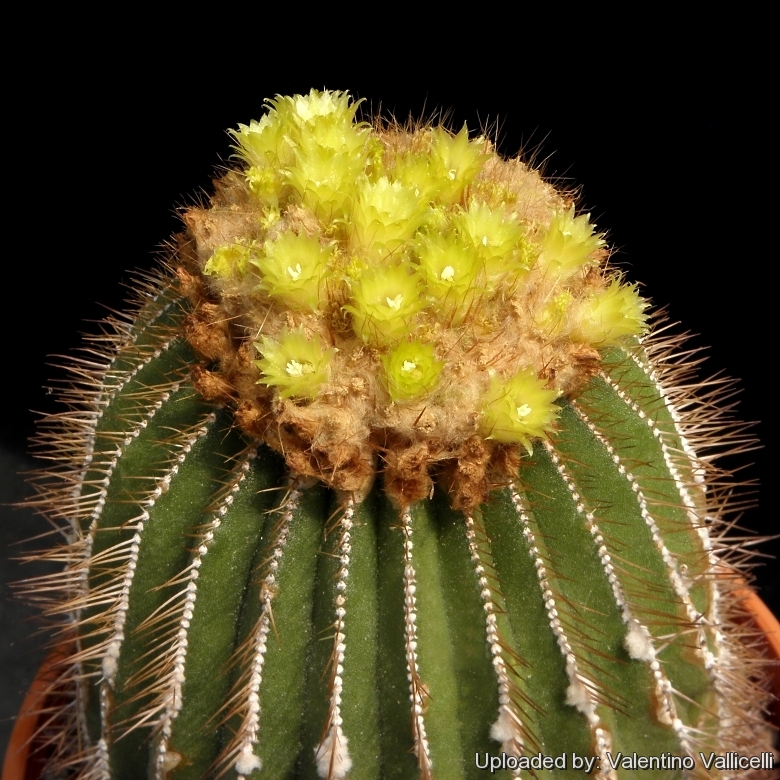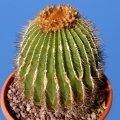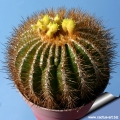
Uebelmannia pectinifera subs. flavispina Photo by: Valentino Vallicelli
Origin and Habitat: Brazil (Minas Gerais: Diamantina)
Synonyms:
See all synonyms of Uebelmannia pectinifera
Description: Solitary beautiful globular cactus, having green stems with several ribs and closely-spaced areoles.
Stem: Up to 12 cm wide, 35 cm tall, very woolly in the apex. Plants in this genus always show woodiness in the lower stem as they age.
Ribs: 20 to 29 prominent
Areoles: Close set.
Central spines: 1 to 4 up to long 1.5 cm, amber yellow.
Flowers: Yellow and diurnal in late autumn, or spring.
Remarks: The Uebelmannia flavispinaSN|14312]]SN|14314]] and all the other plants belonging to the Uebelmannia pectiniferaSN|14314]]SN|14312]] complex are very variable in habitat, it has three recognized subspecies, but a multitude of different forms exist, where each form is linked to others by populations of plants with intermediate characteristics.
Subspecies, varieties, forms and cultivars of plants belonging to the Uebelmannia pectinifera complex
 Uebelmannia pectinifera Buining: (ssp. pectinifera) It has about 18 ribs and slowly grow up to 50 cm in height. Origin: It comes from the mountains in the higher part of the areal.
Uebelmannia pectinifera Buining: (ssp. pectinifera) It has about 18 ribs and slowly grow up to 50 cm in height. Origin: It comes from the mountains in the higher part of the areal. Uebelmannia pectinifera var. crebispina n.n.: Barao de Quacuy, Minas Gerais, Brazil.
Uebelmannia pectinifera var. crebispina n.n.: Barao de Quacuy, Minas Gerais, Brazil. Uebelmannia pectinifera var. eriocactoides Řepka, Krajča & V.Toman: The seedlings closely resemble to juvenile plants of Eriocactus leninghausii, hence the name.
Uebelmannia pectinifera var. eriocactoides Řepka, Krajča & V.Toman: The seedlings closely resemble to juvenile plants of Eriocactus leninghausii, hence the name. Uebelmannia pectinifera subs. flavispina (Buining & Bredero) P.J.Braun & Esteves: It has up to 29 ribs with amber yellow spines, and can grow about 35 cm tall. Origin: west of Diamantina.
Uebelmannia pectinifera subs. flavispina (Buining & Bredero) P.J.Braun & Esteves: It has up to 29 ribs with amber yellow spines, and can grow about 35 cm tall. Origin: west of Diamantina. Uebelmannia pectinifera subs. flavispina var. longispina n.n.: like subsp. flavispina, but spines longer and thicker. Distribution: Guinda, Minas Gerais, Brazil.
Uebelmannia pectinifera subs. flavispina var. longispina n.n.: like subsp. flavispina, but spines longer and thicker. Distribution: Guinda, Minas Gerais, Brazil. Uebelmannia pectinifera subs. horrida (P.J.Braun) P.J.Braun & Esteves: Stem with more than 23 ribs (up to 40) it is the taller of the three and can reach 1 m of height. Origin: Serra do Espihaço.
Uebelmannia pectinifera subs. horrida (P.J.Braun) P.J.Braun & Esteves: Stem with more than 23 ribs (up to 40) it is the taller of the three and can reach 1 m of height. Origin: Serra do Espihaço. Uebelmannia pectinifera var. multicostata Buining & Bredero: has 20 or more ribs. Distribution: 10 km E of Mendanha towards the Rio Jequitinhonha, Minas Gerais, Brazil.
Uebelmannia pectinifera var. multicostata Buining & Bredero: has 20 or more ribs. Distribution: 10 km E of Mendanha towards the Rio Jequitinhonha, Minas Gerais, Brazil. Uebelmannia pectinifera var. pseudopectinifera Buining: has smaller and greener stems, with separate (not confluent) areoles without brush-like spines. Distribution: Diamantina, Minas Gerais, Brazil.
Uebelmannia pectinifera var. pseudopectinifera Buining: has smaller and greener stems, with separate (not confluent) areoles without brush-like spines. Distribution: Diamantina, Minas Gerais, Brazil. Uebelmannia pectinifera f. variegata hort.
Uebelmannia pectinifera f. variegata hort.
Bibliography: Major references and further lectures
1) Edward Anderson “The Cactus family” Timber Press, Incorporated, 2001
2) James Cullen, Sabina G. Knees, H. Suzanne Cubey "The European Garden Flora Flowering Plants: A Manual for the Identification of Plants Cultivated in Europe, Both Out-of-Doors and Under Glass" Cambridge University Press, 11/Aug/2011
3) David R Hunt; Nigel P Taylor; Graham Charles; International Cactaceae Systematics Group. "The New Cactus Lexicon" dh books, 2006
4) Machado, M., Taylor, N.P. & Braun, P. 2013. Uebelmannia pectinifera. In: IUCN 2013. "IUCN Red List of Threatened Species." Version 2013.2. <www.iucnredlist.org>. Downloaded on 08 January 2014.
 Uebelmannia pectinifera subs. flavispina Photo by: Valentino Vallicelli
Uebelmannia pectinifera subs. flavispina Photo by: Valentino Vallicelli Uebelmannia pectinifera subs. flavispina Photo by: Valentino Vallicelli
Uebelmannia pectinifera subs. flavispina Photo by: Valentino Vallicelli Uebelmannia pectinifera subs. flavispina Photo by: Cactus Art
Uebelmannia pectinifera subs. flavispina Photo by: Cactus Art Uebelmannia pectinifera subs. flavispina Photo by: Cactus Art
Uebelmannia pectinifera subs. flavispina Photo by: Cactus Art Uebelmannia pectinifera subs. flavispina Photo by: Prof. Ilham Alakbarov
Uebelmannia pectinifera subs. flavispina Photo by: Prof. Ilham Alakbarov Uebelmannia pectinifera subs. flavispina Photo by: Valentino Vallicelli
Uebelmannia pectinifera subs. flavispina Photo by: Valentino Vallicelli Uebelmannia flavispina/pectinifera intermediate. Photo by: Cactus Art
Uebelmannia flavispina/pectinifera intermediate. Photo by: Cactus Art Uebelmannia pectinifera subs. flavispina Photo by: Valentino Vallicelli
Uebelmannia pectinifera subs. flavispina Photo by: Valentino VallicelliCultivation and Propagation: Not easy; it has a large root and lives among rocks. This tropical cactus prefers loves warm, moist, humid conditions, and mist spraying is a must in summer. Water regularly during the growing season and use a very draining mineral potting substrate. At the onset of winter, do not water. Uebelmannias need heat all year round, and extra winter heat; minimum 10°C is best. Avoid any frost. Keep cool in summer. This plant proves to be root prone if kept too cold in winter. To help stop this, a good deep collar of pumice or lava grit is an excellent idea. It prefers a full sun position and possibly afternoon shade in summer. If you can place it so that this occurs, the plant will be much happier.
Propagation: By seeds. Germinating seeds can also be tricky. But plants are often grafted making them easier to grow, particularly through the winter. If possible, using a rootstock that is hardier than the Uebelmannia is the ideal.
Your Photos

by Valentino Vallicelli

by Valentino Vallicelli

by Valentino Vallicelli

by Cactus Art






















